Catholic Saint with Two Skulls gets blue eyes, dental treatment 1300 years after death
Saint Mundita lost her flesh when she was removed from her grave. But she got fresh Jewels in her eye socket, and glitter all over her skeleton.
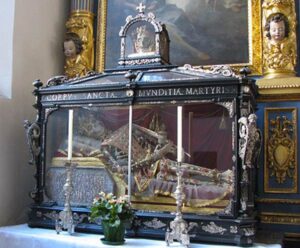
This Catholic saint that is displayed for adoration and veneration in St. Peter’s Church in Munich, is one of its kind.
The Vatican is not sure exactly when she died. The best guess is around 300 A.D. But her remains were kept in the catacombs of Cyriaca.
What we know is that her remains were shifted from Rome to Munich in Germany in 1675 A.D. And 1300 years after she died, she got Jewels as eyes, and even “dental treatment”.
From Wikipedia;
Saint Munditia is venerated as a Christian martyr. Her relics are found in a side altar at St. Peter’s Church (known as “Old Peter,” Alter Peter) in Munich. They consist of a gilt-covered and gem-studded skeleton, located in a glass case, with false eyes in her skull, which is wrapped in netting. Jewels cover the mouth of the relic’s rotten teeth.
Her relics were translated to Munich from Rome in 1675 from the catacombsof Cyriaca. They were transferred to her Baroque Era–shrine was built on September 5, 1677.
In 1804, her relics were concealed behind a wooden shrine, but this was removed in 1883, restoring interest in her cult. Her feast day is now celebrated annually with a High Mass and a procession with candle.
Lets take a look at the Saint with two skulls. One on the skeleton, and one in the box on top of the coffin.
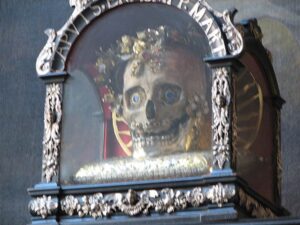
A blue eyed skeleton in a box, with the moth region and teeth covered with jewels.
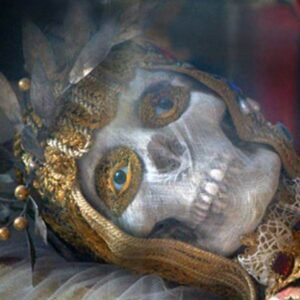
The skull on the skeleton on the Saint, has got stony blue eyes. The skull is dressed up for adoration.
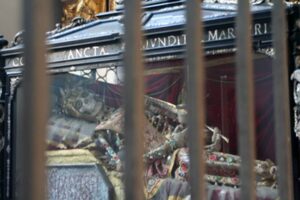
The skeleton is covered with Jewels and glitter.
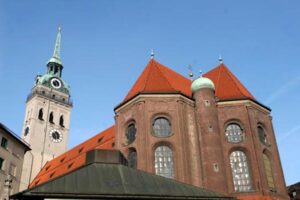
Inside St.Peters Church in Munich you will find more wickedness executed by some Papists.
Vahni Capildeo‘s poem, called “Saint Munditia”, is found in her collection No Traveller Returns, in which she describes the saint as being “dug up from her burial / a millennium and a third since the flesh fell off her.
Source: Wikipedia
The saint with two skulls?
Why do the Catholic feel the urge to pray in front of and to venerate, and adore these skulls?